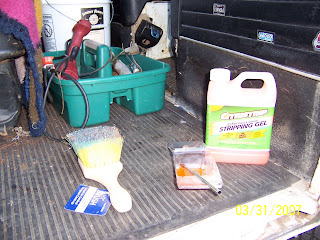 derlying or surrounding paint.
derlying or surrounding paint.I ended up using a chemical stripper. Some who read this will be aghast, & say the buffer was the way to go. Based upon experience, and hindsight, they may well be right.
But, that ship has sailed, as they say, & I think the results are pretty good.
I tried methelyne chloride (Kleen-Strip) first, on one of the numbers on the rear hatch. that was NOT the way to go. Way too active, & wanted to take the under lying paint off, too. Since the paint used for the graphics was probably acryl
 ic, I reasoned that a relatively benign agent could lift the graphics while leaving the underlying enamel mostly unaffected.
ic, I reasoned that a relatively benign agent could lift the graphics while leaving the underlying enamel mostly unaffected.
Citra-Solv worked, for the most part, the way I wanted. A couple of areas were damaged, but that was user error (leaving it on too long). I made up some touch-up paint using plain white tractor & implement enamel mixed with Allis-Chalmers White (both from Tractor Supply) & I'm using a fine brush to apply it.
Now, I can here some collective shudders out there, but that's the way I'm doing it, & the touched-up areas easily pass the 10-ft/10mph rule.
I applied the Citra-Solv with an acid brush, let it sit until I could scrub some paint off with the brush, then scrubbed hard with the brush & followed with a water rinse, wiped with a paper towel, & removed what traces were still clinging on with a paper towel & acetone.

 As you can see, the letters came up easily enough. The front end, especially, looks much better, I think.
As you can see, the letters came up easily enough. The front end, especially, looks much better, I think. The one big problem I had was related to temperature, & my own laziness. I'd been working for several days in my garage, where I have a furnace that can get it up to 40 or 50 (Farenheight) if it's at least 20 outside. I'd been letting the stuff sit for hours while I worked on other things, & sometimes overnight in 30 to 40 degree temperatures.
The one big problem I had was related to temperature, & my own laziness. I'd been working for several days in my garage, where I have a furnace that can get it up to 40 or 50 (Farenheight) if it's at least 20 outside. I'd been letting the stuff sit for hours while I worked on other things, & sometimes overnight in 30 to 40 degree temperatures.Well, we had a couple of warm days, and I was out one night, working without the furnace in 60 degree temperatures, when my wife called on the cell to let me know dinner was ready. I left the stripper on, since I'd safely left it on for long periods before, & went in for a wonderful home-cooked dinner (Thanks, Sherrie!) accompanied by an excellent bottle of wine.
Being full of food & wine, I decided the Bus would be OK overnight, not accounting for the 30-40 degree rise in the temperature.
Went out in the morning to find a LARGE AREA OF ORIGINAL PAINT PEELING OFF!!!
Horrors!!!
I quickly scrubbed & rinsed & acetone-wiped the area, to minimize th
 e damage. Later, when everything had dried, I put aluminum tape over it to stave off the rust, & I'll paint it later.
e damage. Later, when everything had dried, I put aluminum tape over it to stave off the rust, & I'll paint it later.LESSON LEARNED: If you try this , be really careful about temperature. I remember (now, D'ohh!!) from high-school chemistry, that chemical reactions are facilitated by higher temperatures. In this case, I think the effect was exponential. What was a stable, slow acting agent at 30-40 degrees became much more active at 60 degrees!
It should all work out, though, I'm not going for a showroom finish here, & I may very well put on some graphics of my own. I've got good matching touch-up paint.
There are some "ghost " images left from the original graphics, & some yellowing here & there, but that should all buff out well enough. Remember, 10 ft/10mph!!!!
Next: Interior & Rear Cargo Hatch Gasket.

No comments:
Post a Comment